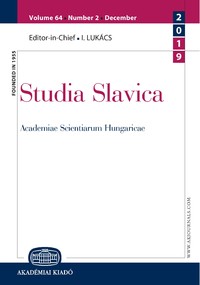Конструкции с предлогом О со значением ‘основания деятельности, средства’: инновация или индоевропейское наследие?
Constructions with the preposition O meaning ‘basis of activity, means’: an innovation or an Indo-European heritage?
Author(s): Ludmila Viktorovna Bratukhina, Alexandr Yuryevich BratukhinSubject(s): Eastern Slavic Languages
Published by: Akadémiai Kiadó
Keywords: the preposition О; case functions; Old Slavonic; Church Slavonic; Old Russian; Sinai Psalter; Zograf Gospel; Ostromir Gospel; Ostrog Bible; Elizabethan Bible
Summary/Abstract: The paper is devoted to analyzing examples of the use of constructions “O + locative”, which have the meaning of “basis of activity, instrument”. Our interest in these examples is due, firstly, to the fact that this meaning of the preposition O is completely absent in modern Russian. Secondly, in some cases, this construction found in Old Slavonic texts is replaced in Church Slavonic by the construction “ВЪ + locative”, which is a calque from the ancient Greek construction “dí + dative” (often having the meaning of “a tool”) but this substitution is inconsistent. Thirdly, the constructions “O + locative” and “BЪ + locative” appear in the Old Slavonic manuscripts in parallel. The main aim of the study is to identify the shades of meaning that the creators of Old Slavonic texts distinguished in the ancient Greek construction “dí + dative”, choosing “O + locative” as a variant of translation; and to determine whether the indicated meaning of the preposition O was original in the Slavic languages or this preposition was acquired in the process of translating Biblical texts. The research is based on the Sinai Psalter, the Zographic and Ostromir Gospels, the Ostroh and Elizabethan Bibles as well as the examples (contained in the dictionaries of the Old Slavic, Old Russian, and Church Slavonic languages) from the Mariinsky Four Gos- pels, Assemaniev’s Gospel, Savin’s book, Euchology of Sinai, and Supralsky manuscript. The construction “dí + dative” is translated not only by “O + locative”. The former is also regularly translated by constructions of the instrumental case without a preposition (in Old Slavonic and Church Slavonic texts). The possibility of forming of the meaning of the action source under the influence of the construction “OTЪ + genitive” is also considered. In general, the dynamics of evolution of the meaning of “O + locative” is traced in the paper. It is concluded that the analyzed “O + locative” construction acquired the meaning of “basis of activity, instrument” at the time of the creation of Old Slavonic Bible transla- tions. This is due to the process of reflection on the text, which became possible with the appearance of the written Slavonic language and the comparison of this construction with a simple instrumental case, combinations of “OTЪ + genitive” and “BЪ + locative”, which in some cases acted as synonymous and could be chosen by translators either spontaneously or with the aim to express nuances of meaning. This is demonstrated with the elimination of ancient Greek tracing, as well as the reverse replacement of “O + locative” by “BЪ + locative”. The instrumental case without a preposition was similar to “O + locative” in the expression of the causal meaning as well as in indicating the source of the action; the con- struction of “OTЪ + genitive”, in addition to the similarity of meaning, in terms of spelling and phonetics also resembled “O + locative”. The construction “O + locative” turned out to be more stable in the cases of indicating an animate source or basis of activity.
Journal: Studia Slavica Academiae Scientiarum Hungaricae
- Issue Year: 64/2019
- Issue No: 2
- Page Range: 279-291
- Page Count: 13
- Language: Russian
- Content File-PDF

